The sartorius is known for two types of pain, burning stinging sensations and sharp stabbing pain. Because the sartorius muscle lies right below the skin, the pain and burning sensations can feel like it originates in the skin itself.
The burning and stinging sensations are associated with trigger points in the muscle. They can be experienced anywhere along the length of the sartorius; however, it most often occurs toward the inside of the knee.
Sudden sharp pain is an indicator of a muscle strain. If the muscle strain is mild, the pain may feel more like a cramp. Moderate and severe muscle strains cause stabbing pain that can be debilitating.
Trigger point pain and pain caused by a muscle strain share some common symptoms but require different treatment methods. It is crucial to understand the differences so that the correct treatment technique is applied.
Where Is The Sartorius Muscle?
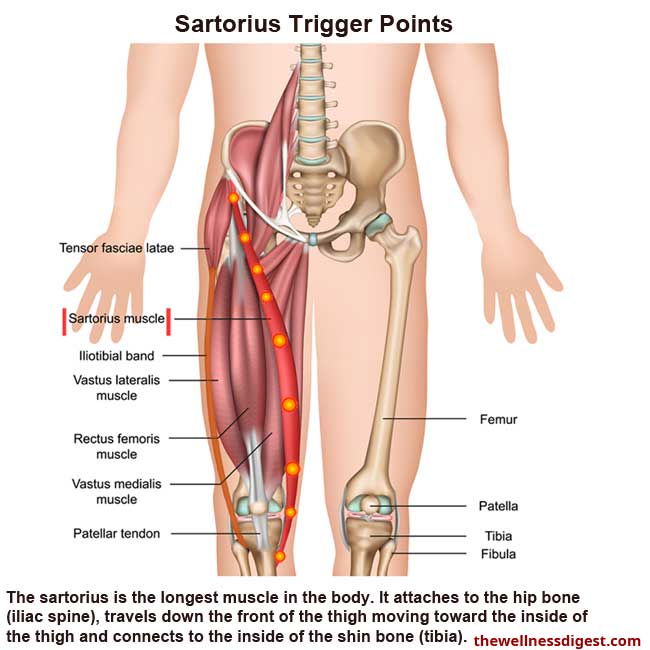
The sartorius muscle attaches to the hip bone (iliac spine), travels down the front of the thigh, moving toward the inside of the thigh, and connects to the inside of the shin bone (tibia). Because it attaches to the hip and knee, it initiates movement in both the hip and knee joints.
What Movements Does It Control?
- Bends (flexion) the thigh at the hip. Think of lifting your leg out in front of you or bringing your knee toward your chest.
- Twists the leg out and away from the other leg. (lateral rotation)
- Bends the knee (flexion)
- Twists the knee in toward your other leg. (medial rotation)
Sartorius Muscle Anatomy page has origin, insertion, innervation, and blood supply information.
Advertisement
Sartorius Muscle Trigger Points Symptoms:
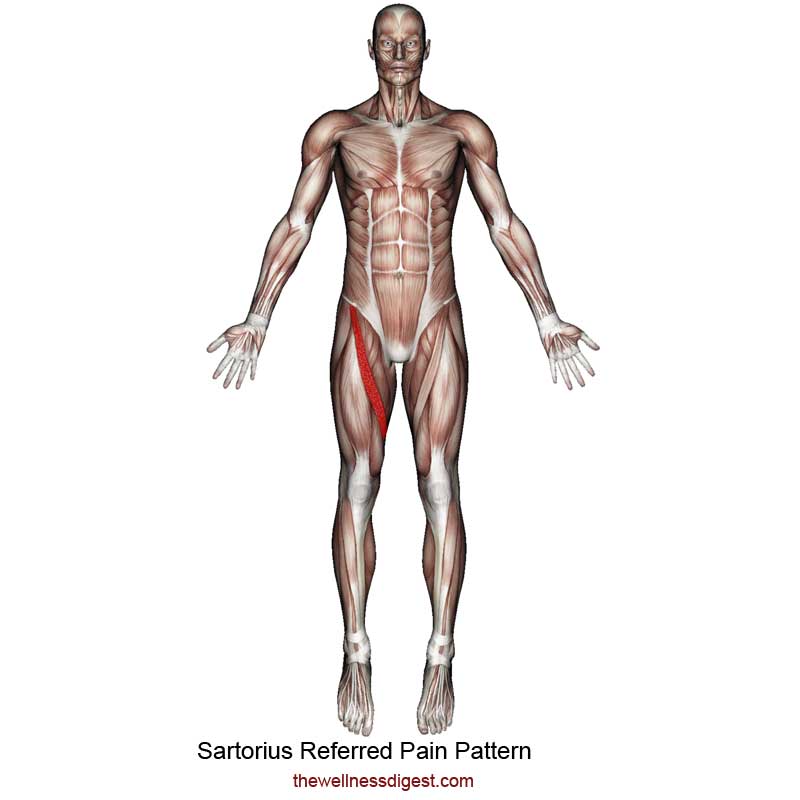
Trigger points in the sartorius can cause pain at many points in the muscle. Keep in mind that trigger points in this muscle do not radiate pain far from the trigger point. If you are experiencing pain near the hip, the trigger point will be in the upper portion of the muscle. If the pain is near the knee, the TrP will be in the lower leg near the knee.
Signs and symptoms include:
- Burning and tingling along the muscle or segments of the muscle
- Sharp stabbing pain that is felt just under the skin along the length of the muscle
- Sharp pain when you step back too far
- Stabbing pain when you lift the leg behind the body
- Stabbing pain when you twist the knee
- The inside of the knee may become hypersensitive
- Sitting will relieve pain
- Sleeping with a pillow between the knees relieves the pain.
TWD Recommends
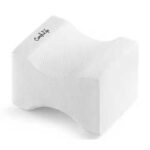 The ComfiLife Knee Pillow was developed for side sleepers to keep your leg aligned with your hip and spine, decreasing your pain while you sleep. Highly recommended for sartorius muscle pain.
The ComfiLife Knee Pillow was developed for side sleepers to keep your leg aligned with your hip and spine, decreasing your pain while you sleep. Highly recommended for sartorius muscle pain.
 The Professional Choice Knee Brace is one of the best on the market. Comfortable to wear, and it provides support without binding. The brace helps hold the kneecap in place, stabilizing the joint. The brace works well for knee pain attributed to the sartorius trigger points.
The Professional Choice Knee Brace is one of the best on the market. Comfortable to wear, and it provides support without binding. The brace helps hold the kneecap in place, stabilizing the joint. The brace works well for knee pain attributed to the sartorius trigger points.
What Causes Trigger Points To Develop?
- Sitting cross-legged and in the lotus pose puts enormous strain on the sartorius.
- Sitting with your legs up and crossed in a recliner or resting on an ottoman
- Sleeping on your back or stomach with your legs crossed
- Slipping or taking a misstep
- Planting your foot and pivoting, making a sharp turn
- Pushing off your foot hard to accelerate quickly
- Sports and activities that require fast turns, pivots, quick acceleration, and extended strides
TWD Recommends
 The Sparthos Thigh Compression Sleeve provides compression as well as support for thigh muscles. It stays in place, it does not slide down, the top doesn’t roll down, and the bottom does not roll up during movement.
The Sparthos Thigh Compression Sleeve provides compression as well as support for thigh muscles. It stays in place, it does not slide down, the top doesn’t roll down, and the bottom does not roll up during movement.
How To Avoid Development of Trigger Points In The Sartorius
- If you habitually sit with your legs up, occasionally drop them down and rest your feet on the floor. Even better, get up and walk around.
- Before walking, jogging, running, exercise, or participating in sports, take time to warm up and do some light stretches.
- Take time to stretch out upper and lower leg muscles after running and exercise.
- When walking on slick surfaces, pay attention to your steps. Don’t slip, don’t fall!
- If practicing yoga, be aware that the tree pose, lotus pose, butterfly pose (stretch), and fire log pose are stressful for the sartorius muscle. Don’t try to push beyond what your muscles are capable of doing.
 Sombra Warm Therapy Gel is recommended for relaxing muscles and relieving pain. It warms without the burning heat of other gels. An excellent choice for pain caused by trigger points, muscle/joint over-use and stiffness, and arthritis. (Not sold in stores)
Sombra Warm Therapy Gel is recommended for relaxing muscles and relieving pain. It warms without the burning heat of other gels. An excellent choice for pain caused by trigger points, muscle/joint over-use and stiffness, and arthritis. (Not sold in stores)
 Biofreeze Professional Gel is recommended by doctors and trainers for the pain and symptoms of muscle strains. It provides excellent pain relief and may help reduce inflammation caused by a strain.
Biofreeze Professional Gel is recommended by doctors and trainers for the pain and symptoms of muscle strains. It provides excellent pain relief and may help reduce inflammation caused by a strain.
Sartorius Trigger Point Treatment
Sartorius trigger points are easy to treat because the muscle lies just under the skin. Many massage therapists, physical therapists, athletic trainers, and chiropractors are trained in trigger point therapy. Having a trained professional find the TrPs and show you how to treat them is the easiest way to learn about trigger point therapy and treatment.
If you have patience are willing to practice, you can learn the therapy. The Trigger Point Therapy Workbook is a great resource to learn about and how to treat TrPs. Once you learn the feel and where to look for trigger points, you will be able to self-treat and reduce muscle pain throughout the body.
Trigger point therapy is most effective when the TrPs are treated several times during the day for 1-2 minutes per treatment. Consistency is important for optimal treatment outcomes.
How Long Before I Feel A Reduction In Pain?
Because the sartorius muscle lies just beneath the skin and the trigger points are easy to treat, you will notice relief after a few treatments. Keep in mind is that consistency is the key. You must continue with treatments until the symptoms, as well as the trigger point, are gone.
Interesting facts:
- The sartorius is the longest muscle in the body.
- Sometimes called the tailor’s muscle. Before sewing machines, many tailors would sit cross-legged while they sewed. Hours of sitting in this position produced pain along with the sartorius muscle. Pain in the front of the hips, inner thighs, and knees was commonplace for those in the tailoring trade.
Sartorius pain and symptoms can be similar to, contribute to, and be affected by these medical diagnoses:
- Sprain or strain in the upper thigh muscles
- Knee strain or sprain
- Floating Patella
- Meniscus tear
- Anterior cruciate ligament tear (ACL)
- Posterior cruciate ligament tear (PCL)
- L2 L3 or L4 radiculopathy
- Meralgia Paresthetica (Bernhardt’s Disease)
Advertisement
Other muscles that should be considered and examined:
Satellite trigger points associated with the sartorius muscle:
Trigger points often produce other TrPs in other muscles, which are known as satellite trigger points. If you have trigger points in the sartorius, check these muscles:
- Rectus femoris
- Vastus medialis
- Adductor magnus
- Adductor longus
- Adductor brevis
TWD Recommends

Doctors and physical therapists often recommend TENS to relax the muscles and ease the pain. The Belifu TENS Unit Muscle Stimulator is highly recommended and an excellent choice for treating upper leg pain.
Sartorius Muscle Strain
A sartorius muscle strain pain can range from a pulling sensation to excruciating pain. Strains can occur anywhere in the muscle but are most likely to happen at the knee attachment. A muscle strain is graded progressively determined by the number of muscle or tendon fibers that tear during injury.
Grade 1 is a mild strain in which a small number of fibers tear. Grade 1 strains can produce a sharp pain, but it is usually a feeling of tightness or a pulling sensation. Redness, minor bruising, and swelling may occur. Normal daily activities are generally not affected, though there may be some tenderness and discomfort in the muscle.
A Grade 2 strain is a moderate strain, in which a significant number of muscle or tendon fibers tear. Immediate pain along with a hard pulling, popping or tearing sensation is often felt. The leg may feel weak, and pain may cause you to limp. Redness, bruising, and swelling will likely develop over the following hours or days. Pain and weakness will make you stop whatever activity you were doing. Daily activities will likely be affected after injury.
Grade 3 is a severe strain, where most or all of the muscle fibers tear. The pain will be immediate and incapacitating. Bruising and swelling will be visible right away. Putting weight on the leg will be extremely painful and may be impossible due to pain and muscle weakness. Daily activities will be affected.
Symptoms of a Sartorius Muscle Strain:
- The area around the injury may turn red and feel warm or hot when touched.
- Moving the leg may cause pain to intensify.
- The leg may feel weak during weight-bearing.
- Walking is painful, causing you to limp.
- Putting weight on the leg increases the pain. If the strain is severe, placing weight on the leg may be impossible.
- Redness and bruising develop on the inside of the thigh and/or knee.
- Swelling around the area where the strain occurred.
- A bump or indentation is felt where the fiber tears occurred.
TWD Recommends
 The Odofit Support Brace has three adjustable straps that allow you to adjust the compression to your needs. The waistband holds the brace in place. The Odofit is one of the best for moderate and severe thigh and groin pain and injury.
The Odofit Support Brace has three adjustable straps that allow you to adjust the compression to your needs. The waistband holds the brace in place. The Odofit is one of the best for moderate and severe thigh and groin pain and injury.
What Causes Sartorius Strains?
Sartorius strains most often occur in activities that require fast hard turns and quick acceleration. When you plant your foot to do a quick pivot, there is a twisting motion in the hip and the knee, which can cause muscle tears in the sartorius and other thigh muscles. Contact sports pose a risk if the muscle takes a direct hit or is mashed when another player falls on the upper leg.
Another contributor to strain is over-use and repetitive motions. The muscle becomes stressed and tired after repeatedly doing the same motions over and over, leaving muscles fibers vulnerable to tears.
Sports and activities that contribute to sartorius injury:
- Contact Sports
- Hockey
- Rugby
- Soccer
- Football
- Basketball
- Over-use and Repetitive Motions
- Running
- Cycling
- Skiing
- Gymnastics
- Swimmers – the constant kicking motion can overwork the sartorius
- Exercises requiring deep knee bends
TWD Recommends
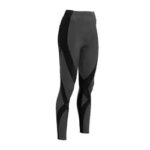 The CW-X Endurance Pro Tights were made specifically to support adductors, quads, hamstring muscles, and the knees. Highly recommended for runners, cyclists, and other athletes. Men's Tights and Women's Tights
The CW-X Endurance Pro Tights were made specifically to support adductors, quads, hamstring muscles, and the knees. Highly recommended for runners, cyclists, and other athletes. Men's Tights and Women's Tights
Sartorius Strain Treatments
Most sartorius strains are mild or moderate and can be safely treated at home using the P.R.I.C.E. protocol.
Begin the P.R.I.C.E. protocol as soon as possible:
- Protect – Stabilize and restrict movements of the thigh and knee with an Ace bandage or Velcro wrap if the strain is moderate or severe.
- Rest – Rest the leg as much as possible. Healing takes place during rest and sleep, take naps, and get extra sleep at night.
- Ice – Use ice packs every 1-2 hours until pain and swelling start to decrease. Leave the ice in place for 20 minutes per treatment. Using cold treatment longer may damage soft tissues.
- Compression – Applying moderate pressure with an Ace bandage or Velcro wrap discourages swelling and provides support.
- Elevation – Propping the leg up on pillows prevents fluids from accumulating around the injury and helps reduce pain and swelling.
Once swelling, heat, and redness have diminished, begin alternating cold and heat treatments. Use cold for a 20-minute treatment, then wait 1-2 hours and apply heat for 20 minutes.
TWD Recommends
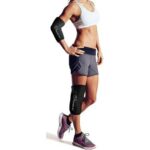 TheraICE Rx Hot & Cold Therapy provides 360 degree cold and warm therapy. The sleeve provides compression, which helps reduce inflammation and pain. An excellent choice for adductor and trigger point pain treatments.
TheraICE Rx Hot & Cold Therapy provides 360 degree cold and warm therapy. The sleeve provides compression, which helps reduce inflammation and pain. An excellent choice for adductor and trigger point pain treatments.
 The Vive Thigh Brace is another choice for thigh muscle support and compression. The brace is adjustable and stays up on the leg well. Provides warmth for muscle relaxation.
The Vive Thigh Brace is another choice for thigh muscle support and compression. The brace is adjustable and stays up on the leg well. Provides warmth for muscle relaxation.
How Long Does It Take A Sartorius Strain To Heal?
- Mild Grade I strains heal quickly, usually within 1-3 weeks.
- Moderate Grade II strains healing times vary depending on the number of fibers torn. Most heal in 4-12 weeks.
- Severe Grade III strains require medical attention and can take anywhere from a few months up to a year to heal.
Tips To Avoid Sartorius Strains
- Before sports, exercise, and other strenuous activities, take time to warm up
- Take a few minutes to stretch and cool down after activities
- Wear proper shoes with suitable soles for sports and other activities
- Avoid stiff and hard-soled shoes
- If the muscle feels weak, sore, or is injured, take recovery days to rest and allow the muscle time to heal.
Muscles That Contribute To These Conditions:
ANTERIOR CRUCIATE LIGAMENT | BERNHARDTS DISEASE | FLOATING PATELLA | HIP PAIN | KNEE PAIN | MENISCUS | POSTERIOR CRUCIATE LIGAMENT | UPPER LEG PAIN

